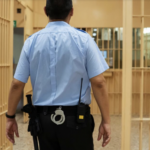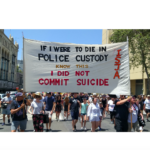Australian Prison Life: Part 3, Mental Health Impact of Imprisonment

Being taken away from your loved ones and everything that’s familiar in life, deprived of your freedom, dehumanised and subjected to a strict daily routine for a prolonged period of time can take an enormous mental toll on any person, and lead lasting and even life-long psychological scars.
This article seeks to set out what many outside prison walls don’t understand, don’t consider and don’t care about – the mental health impact of being a prison inmate.
Being a prisoner
A typical refrain of many inmates’ thoughts is that they lose not just a sense of identity, but rather their whole identity, as they are no longer known for their profession, be it a musician, truck driver, engineer, or a doctor, leading to a loss of sense of oneself.
An inmate also suffers from profound grief, not for selfish reasons, but for the loved ones they leave behind and can no longer help, particularly elderly parents who may die whilst they are incarcerated and children who they can no longer help with homework and show them they are loved by mum or dad.
Keep it all inside and look strong
Tears are a constant symptom of prison life, despite very few confessing to such emotion.
Lockdowns at the end of a day in prison is when the tears flow, even for the toughest inmates and not only on isolated days, but many days and nights throughout one’s entire sentence, particularly just before you go to sleep.
Paranoia reigns supreme
One of the mental health traits developed by many inmates, who may not have been diagnosed with having a mental illness as such, is that of paranoia.
How so is this reflected? Well, no matter that a spousal relationship may have been without problems prior to the incarceration, perhaps as a result of all male company (looking at men’s prisons) and all that this entails, when a call to one’s partner takes more than a few rings before being picked up; the inmate asks in an accusing tone, what were you doing?
This is not the case in the majority of inmates, but certainly is not an infrequent occurrence.
Parole paranoia
An example of this is on a question put to inmates due to be released which asks them to rate any change in their mental health since entering prison; as being a lot better, a little better, the same, a little worse, a lot worse or unknown. Many suggested that their mental health had improved in prison.
This of course is the answer the majority of inmates would give, being aware that to suggest it had deteriorated may necessitate a delay in parole, or further parole conditions.
Of Indigenous prisoners, the vast majority reported prior to release that their mental health was excellent, very good or good and that they had received culturally appropriate health care in prison; again, being aware of providing the right answers to ensure there are no hiccups in being granted parole.
This was despite less than 9% having received a consultation or treatment from the Aboriginal controlled health organisation or service (ACCHO) or, the Aboriginal medical service (AMS).
Parole is a very intimidating and fearful aspect of prison life.
Illness paranoia
A prisoner is fearful of contracting a fatal illness whilst incarcerated.
An inmate is also cognitive of the fact he or she may develop a mental illness as a result of incarceration and is particularly concerned with the fact that treatment for such an illness within the correctional system is practically non-existent.
There are many instances whereby one had been talking coherently with a peer one day and the following day observe the peer remove all his clothes in the common room and sit on the floor, suffering from some mental illness.
One traumatising thought that haunts an inmate, is the established fact that children of incarcerated parents have been known to develop a mental illness as a result of being abandoned by the parent.
Types of mental illnesses Australian inmates suffer
NSW corrections health service in 2003 published a paper stating that the prevalence of mental illness in the NSW correctional system is substantial and consistent with international findings; and that 46% of reception prisoners and 38% of sentenced inmates had suffered a mental disorder, such as psychosis, or anxiety disorder in the prior 12 months.
It also reported that psychiatric morbidity was more increased in reception prisoners, as opposed to sentenced inmates and that the high rates of mental disorders cannot all be attributed to substance abuse.
Almost 33% screened had an anxiety disorder, with 24% of those suffering from post-traumatic stress disorder (PTSD).
1 in 20 of all prisoners had attempted suicide in the prior 12 months.
This is what imprisonment does to a person. It can create a mental disorder if you haven’t had one prior to incarceration and if you do have one, with the lack of adequate treatment, it generally becomes worse.
It is not that the clinicians do not want to provide adequate treatment, it is simply that there is little or no funding for the types of treatment units necessary, as evidenced by the mental health screening unit (MHSU) at two NSW prisons.
So, the paranoia increases somewhat, knowing that you cannot be treated, should you develop a serious mental illness.
The Australian institute of health and welfare (AIHW) and many other related psychiatric and psychological organisations quote in various forms that mental health is fundamental to social wellbeing and may affect anyone in the community, be it whole families or individuals.
Mental health illnesses include chronic conditions, like anxiety, depression, psychosis and drug and alcohol induced conditions. It may even include post-traumatic stress disorder (PTSD).
This is on the outside, in everyday life, but on the outside, you can be treated.
The recommendations of this comprehensive 2003 analysis were:
- Current screening procedures for reception prisoners should be reviewed and, if necessary updated to improve diagnostic accuracy at the point of reception.
- There should be a case management approach towards mentally ill inmates with high levels of need. Interventions should be adapted to the psychiatric needs of the prisoner with an evidence-based justification.
- There should be co-ordinated pre-release planning involving external agencies in the community.
- Current treatment and rehabilitation programmes for mentally ill prisoners within the prison system should be reviewed to assess whether or not treatment guidelines are adequate.
- Resources should be made available to conduct a more comprehensive survey of prisoners’ mental health covering disorders such as, schizophrenia and attention deficit disorder.
- Drug and alcohol rehabilitation should be integrated into the treatment of mentally ill offenders.
- Residential treatment units should be developed within the correctional setting to house mentally ill prisoners who require a therapeutic environment but not hospitalisation. These units should be staffed by skilled mental health workers and appropriately trained custodial officers.
- Social and psychological programmes, such as cognitive behavioural therapy, should be made available to inmates. Treatment should be multidisciplinary and commensurate with that provided in the community.
- Current transportation practice of inmates with severe mental illness should be reviewed.
- Establish a forensic mental health directorate to coordinate the treatment, care and rehabilitation of forensic patients in NSW.
- The NSW forensic mental health strategy should be adopted by CHS to guide service development and resource allocation.
- Court liaison services in NSW should be expanded to include all magistrate courts to facilitate the diversion into mental health care of those with a mental illness who have been charged with minor crimes.
- The number of secure forensic psychiatric beds in the community should be increased.
- All forensic patients should be transferred out of the criminal justice system and into a community forensic mental health system for care, containment and rehabilitation.
Many of the recommendations were, in part or wholly implemented, though it took several years to complete.
That should have removed any paranoia, one would think.
However, 20 years later the recommendations are woefully underfunded, despite local and international evidence that if it is adequately funded, it will be an unmitigated success for the inmate, his family and society in general.
Whilst initially achieving a measure of success, though certainly not with quite the same achievement as the Dutch program, which greatly reduced the number of prisoners with mental illnesses even going to prison in the first place; it is only with increased funding, will NSW and indeed all of Australia, reach such a potential.
The Dutch were able to close 20 prisons over a 6-year period, by deploying a mental health program, amongst other things, by providing psychological/psychiatric care to those mentally ill accused, who might ordinarily have attracted a prison sentence.
Holland, critically though, provided adequate funding with, since 2004, the Dutch prison rate being halved.
NSW mental health screening units (MHSU) as per recommendation 1:
These units are located within the NSW specific needs cluster, with one situated at the metropolitan remand and reception centre (MRRC) and the other at Silverwater women’s correctional centre (SWCC).
They are run jointly with corrective services NSW (CSNSW) and justice health & forensic mental health network (JH&FMHN) to provide a multidisciplinary approach, as also outlined in the above recommendations.
Also provided are the mental health step down units as advised and staffing with psychologists, including services and programs officers (SAPOs).
The main drawback of the implementation of such wonderful recommendations is apparently the lack of funds to treat the vast number of inmates with mental illnesses, who cannot be treated, due to the men’s facility on opening only able to house 43 inmates and the women’s 10 in the MHSU and the step-down units only capable of housing 110 men and 15 women.
With larger resources, including opening more MHSUs and associated step-down units, including of course vastly increased clinical staff, this recommendation adopted by the government would have the potential to reduce recidivism as has been achieved throughout the Netherlands and Nordic countries, reduce the rate of imprisonment and release healthier inmates back into society.
This was indeed pointed out by Dr Richard Matthews, then chief executive officer of NSW corrections health service in August 2003 and close to 20 years later, it is still in a perilous state, as indicated by a 2018 report into the health of Australian prisoners, reported by the BBC last month.
This is further confirmed by a 2021 NSW inspector of custodial services report which indicates that the MHSU at the MRRC still only has 43 beds and is the only male facility of its kind in NSW.
The step-down units are capable of housing 138 patients, an increase of 13 beds over close to 20 years.
So much for applauding the NSW government when it opened the MHSU in the mid-2000s. It is an absolute disgrace there has been no increase in this wonderful initiative of 2 decades ago!
It is also recently that records of waiting lists from referrals from other NSW correctional facilities for the MHSU have been undertaken, if you can believe that.
This woeful situation in relation to prisoners mental health is replicated throughout all Australian states and territories correctional services.
It is little wonder that paranoia pervades Australian correctional institutions.
It is rather ironical that NSW was the only state which did not provide data for the 2018 NPHDC.
As a result of the covid-19 pandemic, the next NPHDC results will be published in 2023. It will be interesting to see if NSW provides critical data required, not only for the benefit of mentally ill inmates and their families, but Australian society as a whole.
Where did we go wrong?
How Australian prisons became a hotbed for the development of mental health conditions is a subject which has been debated for decades and there has been little or no change to date, predominantly due to the failure of Australian governments funding the reforms adequately; as seen by the MHSU debacle, one of many such debacles in relation to mental health throughout Australian states and territories.
It all started with the deinstitutionalisation of the old system of asylums (psychiatric hospitals and the like) commencing in 1992, after the 1983 Richmond report identified systemic abuse of patients by staff.
This was an inquiry commissioned by the NSW government into health services for the psychiatrically ill and developmentally disabled and resulted in endeavouring to return patients to the community with an array of psychiatric/psychological support resources.
However, it turned out to be an unmitigated disaster, due to being poorly orchestrated and atrociously underfunded, with the effect of patients living on the streets and searching for food, in essence beggars who were ill, with some dying in the process.
This resulted in two further enquiries, in 1991 & 1993, leading to community care with short stays in acute inpatients hospital units, staffed by psychologists, social workers, nurses and occupational therapists.
Once again, this reform was thwarted in terms of achievement by a gross lack of government funding, ultimately leading to a significant number of those patients lacking adequate care.
This in turn saw the criminal justice system, in essence, replacing previous facilities by imprisoning many mentally ill patients, purely and simply, as there was nowhere else they could be put.
Adequate funding is required
As stated by the Australian medical association, the national health and hospitals reform commission, the national advisory council on mental health and the national mental health commission; commonwealth, state and territory governments need to cooperate in order to facilitate change from a fragmented system to one that is inclusive.
However, this needs adequate government funding and if such a system is implemented, it will surely result in less mentally ill patients becoming inmates in Australian prisons.
Sadly, it has been 5 years since the sentiments above were expressed and we are still no further on in terms of inclusiveness and adequate government funding.
Until those two integral components are achieved, we shall continue to see the rate of incarceration in Australian prisons increase, many inmates with mental health problems, continued increases in recidivism and potential further harm to the Australian community.
Fast forward 2023
Professor Stuart Kinner, who heads the justice health unit at the university of Melbourne and sits on the federal government’s national prisoner health information committee stated that we are avoiding spending money now on mental health in prisons and inmates who have ongoing mental health issues will be worse after release.
This in turn will see higher rates of recidivism, with higher rates of death due to suicide and drug overdoses, including higher rates of non-fatal health issues that costs a lot more than is saved.
Professor Kinner ends by saying, “It really begs the question – what’s the point?”
And that is how it has been for decades -simply rhetoric or dare I say lies!
The Horse Whisperer
The lack of adequate treatment in mental health is the segue to the person within a prison who makes prison life more bearable for the inmate community, by filling the space of another lack of adequate health.
In this instance, it is an inmate known as the Horse Whisperer.
This nickname was given to this wonderful man, who was doing many years in prison, for his knowledge of horses and other animals and who was trained in physiotherapy of both humans and animals.
You have seen how the lack of something as critical as mental health is neglected within correctional facilities. Well, you can imagine it is similar with other health ailments, such as physiotherapy, chiropractic & osteopathy treatments. It is difficult to say the least, to be seen in a timely manner, adding to continuing pain and quite frequently, depression.
Well, the horse whisperer was a selfless man who turned nobody away and had an amazingly high level of successful outcomes in his treatment methods.
Sport within prisons is an important therapy, which in addition to being able to release pent up frustrations, provides a sense of being relevant once more and alleviates some of the symptoms of those with mental disorders.
In addition to healing the inflicted, the horse whisperer also made himself available on match days, both in football and soccer to massage those in need of loosening up.
It was not unknown for prisoners at medium and minimum-security correctional facilities throughout the state of Victoria, to request a transfer to the Barwon maximum security prison to be able to be tended to by the horse whisperer.
Throughout the years of his incarceration, the horse whisperer would have treated thousands of inmates with physiotherapy, chiropractic or osteopathic treatments.
Truly, a man who made life more bearable within a prison





